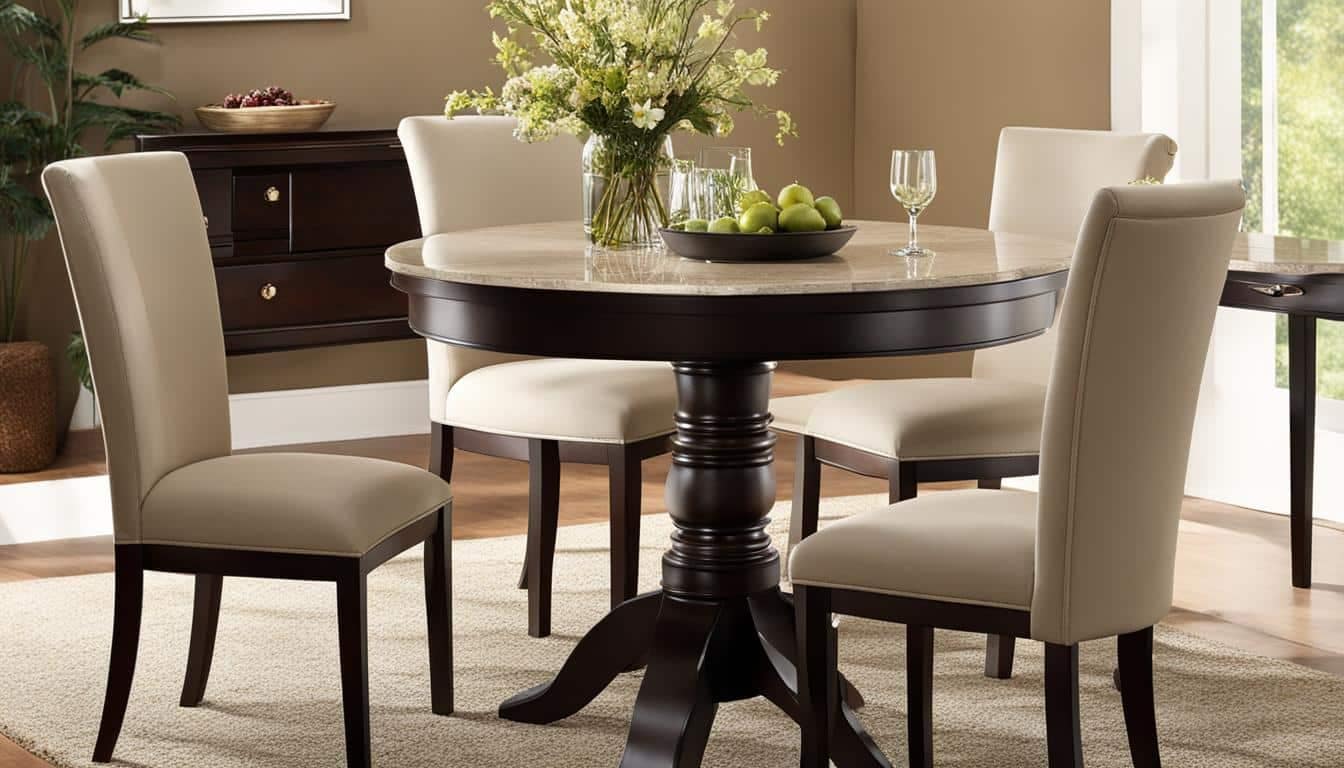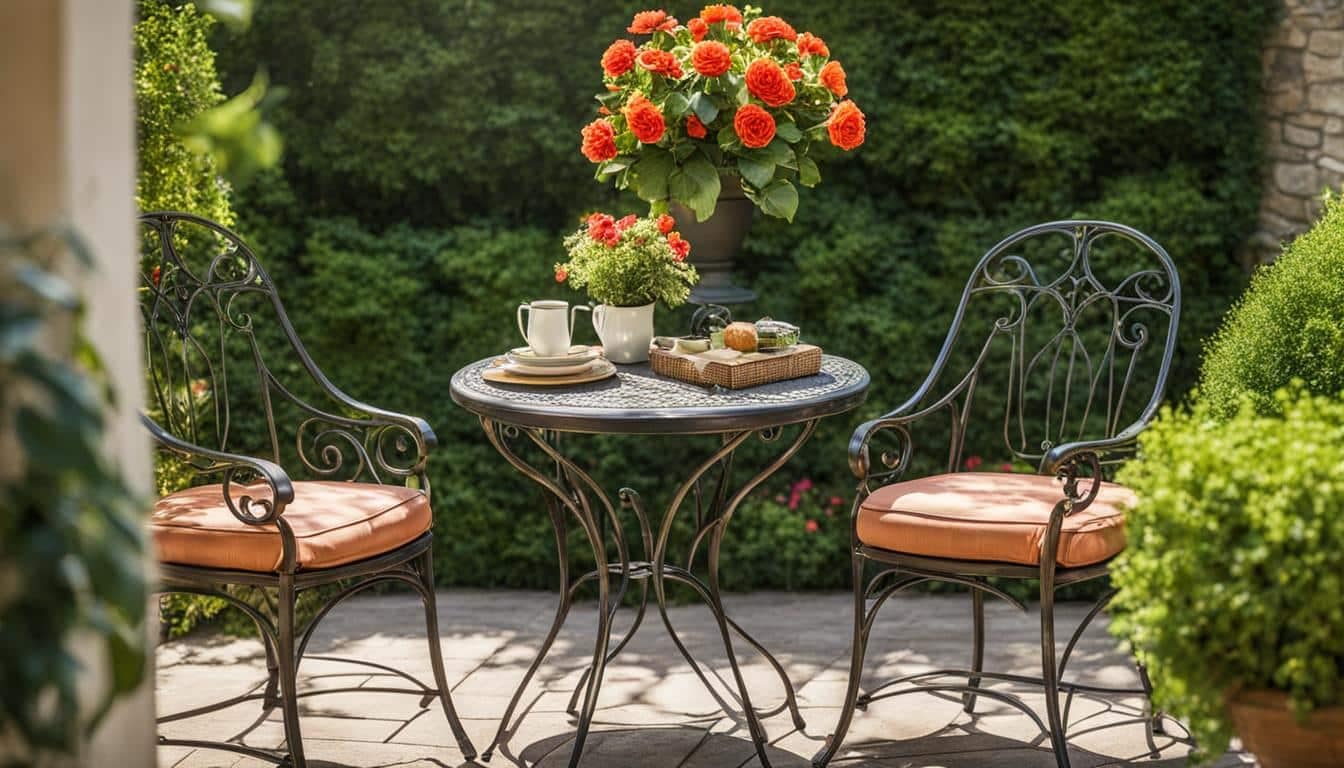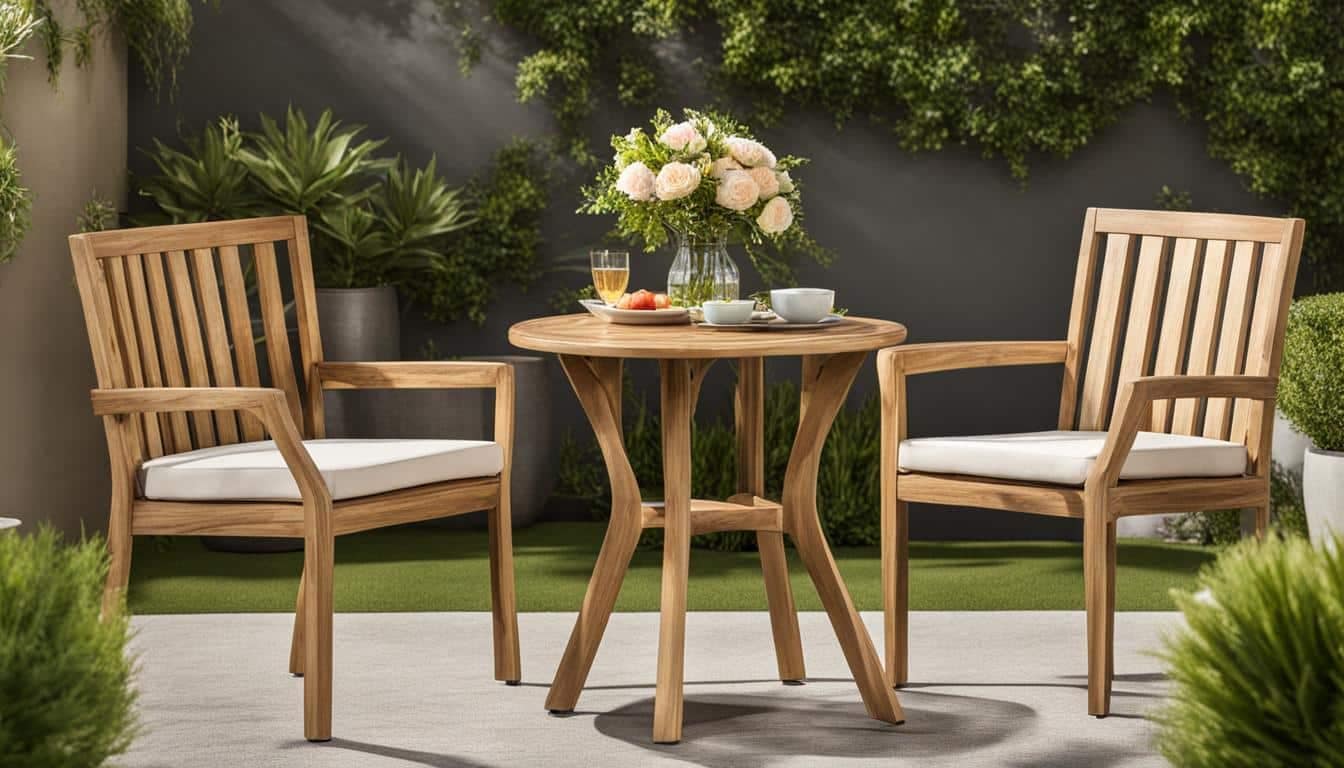Cats can be a nuisance when they use your patio furniture as a scratching post or a bed. Fortunately, there are several effective methods to keep cats off your outdoor furniture. From natural repellents using scents cats dislike, to commercial cat repellent sprays, and physical deterrents like double-sided tape and aluminum foil, you have options to protect your patio furniture. Additionally, creating a cat-friendly space and using training techniques can help redirect the cat’s behavior. By implementing these strategies, you can ensure your patio furniture remains clean and cat-free.
Key Takeaways:
- Use natural repellents like vinegar, citrus peels, and lavender to deter cats from your patio furniture.
- Consider using commercial cat repellent sprays designed specifically for furniture to keep cats away.
- Use physical deterrents like double-sided tape and aluminum foil to make your furniture less appealing to cats.
- Create a cat-friendly space in your yard with enticing toys and scratching posts to redirect your cat’s attention.
- Train your cat using positive reinforcement techniques and verbal commands to stay off the furniture.
Natural Repellents Using Scents Cats Dislike
If you’re looking for a chemical-free and eco-friendly solution to keep cats off your outdoor furniture, natural repellents using scents cats dislike can be highly effective. Cats have a strong sense of smell, and certain scents are known to repel them. By incorporating these scents into your patio space, you can create a cat-free zone and protect your garden furniture from scratching and marking.
Leveraging Vinegar
Vinegar is a readily available household item that can serve as a powerful cat deterrent. Simply mix equal parts of vinegar and water in a spray bottle and apply it to your patio furniture. Cats dislike the strong smell of vinegar, and they will often avoid any areas that have been treated with it. This natural repellent is safe for both your furniture and the environment, making it an ideal choice for cat-proofing your outdoor space.
Utilizing Citrus Peels and Essential Oils
Cats are also known to dislike the scent of citrus. You can create a homemade potpourri by collecting citrus peels and adding a few drops of essential oils such as lemon or orange. Place the potpourri in small bags or sachets and strategically position them around your outdoor furniture. The citrus scent will act as a natural deterrent, discouraging cats from approaching and marking their territory on your patio chairs and tables.
| Natural Repellents Using Scents Cats Dislike | Effectiveness | Ease of Use | Cost |
|---|---|---|---|
| Vinegar | High | Easy | Low |
| Citrus Peels and Essential Oils | Moderate | Moderate | Low |
Note: The effectiveness, ease of use, and cost may vary depending on factors such as cat behavior and outdoor environment.
Commercial Cat Repellent Sprays
If you’re looking for a convenient and hassle-free solution to keep cats away from your patio chairs, commercial cat repellent sprays are a great option. These sprays are specifically designed to deter cats from scratching or marking their territory on your furniture. They typically contain scents that cats find unpleasant, effectively discouraging them from approaching and damaging your outdoor seating.
When using commercial cat repellent sprays, it’s important to follow the instructions on the spray bottle for optimal results. You’ll typically need to apply the spray directly onto the surface of the patio chairs or any areas that cats are prone to target. Be sure to reapply the spray regularly, especially after rainfall or if you notice that the scent has faded.
With commercial cat repellent sprays, you can enjoy your outdoor furniture without the worry of cats leaving scratches or marking their territory. These sprays are a convenient and effective way to keep your patio chairs cat-free, allowing you to relax and enjoy your outdoor space to the fullest.
Table: Comparison of Commercial Cat Repellent Sprays
| Brand | Main Ingredients | Application Frequency |
|---|---|---|
| Pet Master | Natural citrus extracts | Every 2-3 days |
| FelineGuard | Peppermint and eucalyptus oils | Weekly |
| CatAway | Lavender and lemon grass extracts | Every 4-5 days |
In our comparison table, we’ve highlighted three popular brands of commercial cat repellent sprays. Pet Master, FelineGuard, and CatAway offer effective solutions for keeping cats away from your patio chairs. Each brand utilizes different natural ingredients that cats find unpleasant, such as citrus extracts, peppermint, eucalyptus oils, lavender, and lemon grass extracts.
When considering which brand to choose, it’s important to take into account the frequency of application. Some sprays may need to be reapplied more frequently than others to maintain their effectiveness. Additionally, consider any personal preferences you may have for specific scents or natural ingredients.
Physical Deterrents for Cats
When it comes to preventing cats from scratching your patio furniture, physical deterrents can be highly effective. By creating barriers or using certain materials that cats find unpleasant, you can cat-proof your patio furniture and discourage cats from accessing it.
Double-Sided Tape
One physical deterrent that can be used is double-sided tape. Cats dislike the sticky sensation on their paws, so placing double-sided tape on areas where they like to sit or scratch can discourage them from using your furniture as their scratching post. Simply apply the tape to the targeted areas, and the cats will likely find it uncomfortable and avoid those spots.
Plastic Sheeting or Chicken Wire
Another option is to use plastic sheeting or chicken wire to create a physical barrier around your patio furniture. These materials can be draped over the furniture or placed around garden beds to prevent cats from accessing them. Cats generally dislike the texture and feel of these materials, making them less likely to attempt to jump onto or scratch your furniture.
| Physical Deterrent | Effectiveness | Ease of Implementation |
|---|---|---|
| Double-Sided Tape | High | Easy |
| Plastic Sheeting or Chicken Wire | Moderate | Moderate |
By using physical deterrents, you can effectively prevent cats from scratching and damaging your patio furniture. Consider trying these methods to create a cat-free zone and preserve the quality of your outdoor furniture.
Creating a Cat-Friendly Space
If you want to keep cats off your outdoor seating and protect your patio furniture, creating a cat-friendly space in your yard can be a helpful solution. By providing an alternative area that is more appealing to your cat, you can redirect their attention away from your furniture. Here are some tips to help you create a cat-friendly space:
- Include cat attractants: Set up a designated area with catnip, toys, and scratching posts to entice your cat. These items will provide entertainment and satisfy their natural instincts, keeping them occupied and less likely to use your patio furniture.
- Create cozy spots: Cats love to find cozy places to nap and relax. Place soft blankets or pet beds in the cat-friendly space, providing comfortable spots for your cat to rest.
- Provide shelter: If possible, set up a small, enclosed area like a catio or a screened-in porch where your cat can enjoy the outdoors safely. This will give your cat the opportunity to experience fresh air and sunshine without access to your patio furniture.
- Encourage playtime: Engage in interactive play sessions with your cat using wand toys or laser pointers. Regular playtime will help burn off excess energy and prevent boredom, reducing the likelihood of your cat seeking entertainment on your outdoor seating.
By implementing these tips, you can create a cat-friendly space that will fulfill your cat’s needs and keep them away from your patio furniture.
| Cat-Friendly Space Essentials | Benefits |
|---|---|
| Catnip, toys, and scratching posts | Entertain your cat and redirect their attention |
| Soft blankets or pet beds | Provide cozy spots for your cat to nap and relax |
| Enclosed area like a catio or screened-in porch | Offer a safe outdoor environment for your cat |
| Interactive play sessions | Engage your cat’s energy and prevent boredom |
Creating a cat-friendly space not only helps keep cats off your outdoor seating but also enhances their well-being by providing them with an environment that meets their natural instincts and needs. It’s a win-win situation that allows you to enjoy your patio furniture while ensuring your cat’s happiness and satisfaction.
Training Techniques for Cats
Cats can be trained to stay off your outdoor furniture by using positive reinforcement and verbal commands. With patience and consistency, you can teach your cat to respect your boundaries and keep them away from your patio furniture. Here are some effective training techniques to help you achieve your goal:
1. Use Positive Reinforcement
Positive reinforcement involves rewarding your cat for exhibiting desirable behavior. When you notice your cat staying away from the furniture, provide treats or praise to reinforce their good behavior. This positive association will encourage them to continue staying off the furniture.
2. Spray Bottle Training
Using a spray bottle filled with water can deter cats from jumping onto your furniture. When you spot your cat on the furniture, give them a gentle spray of water. Most cats dislike being wet and will associate the unpleasant experience with being on the furniture.
3. Verbal Commands
Teaching your cat verbal commands like “No” or “Get down” can be an effective way to keep them off the furniture. Consistently use the same command whenever your cat attempts to climb onto the furniture. Over time, they will learn to associate the command with the action and stay away.
| Training Techniques for Cats | Description |
|---|---|
| Positive Reinforcement | Rewarding your cat with treats or praise when they stay off the furniture. |
| Spray Bottle Training | Using a gentle spray of water to deter cats from jumping onto the furniture. |
| Verbal Commands | Teaching your cat specific verbal commands like “No” or “Get down” to keep them away from the furniture. |
Remember, consistency is key when training cats. Be patient and persistent in reinforcing the desired behavior and redirecting them away from the furniture. With time and positive reinforcement, your cat will learn to stay off your outdoor furniture and enjoy other designated areas in your home or yard.
Electronic Deterrents for Cats
If you’re looking for high-tech solutions to keep cats off your patio furniture, electronic deterrents can be an effective option. These devices utilize technology to create unpleasant experiences for cats, discouraging them from approaching your furniture.
Ultrasonic Cat Deterrent
One popular electronic deterrent is the ultrasonic cat deterrent. This device emits a high-frequency sound that is highly unpleasant to cats but inaudible to humans. When a cat comes near the patio furniture, the ultrasonic deterrent activates, effectively deterring the cat without causing harm. This method is non-invasive and can be an excellent choice for those who want a hands-off approach to keeping cats away.
Motion-Activated Sprinklers
Another electronic deterrent that has shown success in keeping cats off furniture is motion-activated sprinklers. These devices are equipped with sensors that detect movement. When a cat approaches the designated area, the sprinkler system activates and sprays a burst of water, startling the cat and making them uncomfortable. Over time, cats learn to associate the furniture area with the unexpected water spray and will be deterred from approaching.
| Deterrent | Advantages | Disadvantages |
|---|---|---|
| Ultrasonic Cat Deterrent | – Non-invasive – Safe for cats and humans – Inaudible to humans |
– May not be effective for all cats – Limited range |
| Motion-Activated Sprinklers | – Effective and humane deterrent – Works well in outdoor settings – Easy to install |
– Requires access to a water source – May need regular maintenance |
When using electronic deterrents, it’s important to position them strategically to cover the areas where cats frequently visit. Regular maintenance and checking the devices’ functionality are also crucial to ensure their effectiveness. It’s worth noting that some cats may become accustomed to the deterrents over time, so it may be necessary to switch up the methods periodically to maintain their effectiveness.
Using Aluminum Foil as a Deterrent
If you’re looking for a simple and inexpensive way to keep cats off your patio furniture, consider using aluminum foil. Cats dislike the sound and feel of aluminum foil, making it an effective deterrent. To use this method, simply place sheets of foil on your patio furniture, ensuring that it covers the surfaces cats are likely to jump on. The shiny surface and crinkly texture of the foil are unpleasant to cats, and they will likely avoid it. This technique works best if your furniture is located in an area protected from wind and rain, as the foil may blow away or become damaged.
When using aluminum foil as a deterrent, it’s important to regularly check and replace any torn or damaged sheets. Cats may still attempt to jump on the furniture, so staying vigilant and maintaining the foil’s integrity is key to its effectiveness. Keep spare sheets of foil handy so that you can quickly replace any that become worn or damaged. By consistently using aluminum foil as a deterrent, you can help protect your patio furniture from unwanted feline visitors.
| Pros | Cons |
|---|---|
| Simple and inexpensive | Requires regular maintenance |
| Effective deterrent for many cats | May not work for all cats |
| Easy to implement | Dependent on weather conditions |
Conclusion
Using aluminum foil as a deterrent is a practical and cost-effective method to keep cats off your patio furniture. By utilizing the foil’s sound and texture that cats dislike, you can discourage them from jumping onto your furniture. Although this method requires regular maintenance and may not work for all cats, it is a simple solution that can help protect your patio furniture and maintain a cat-free outdoor space.
Protective Furniture Covers
If you’re looking for a practical and effective way to keep cats off your patio furniture, using protective furniture covers is a great option. These covers act as a barrier, preventing cats from scratching or soiling the fabric of your outdoor furniture. When you’re not using the furniture, simply cover it with these protective covers to keep it safe and free from cat-related issues.
Furniture covers for cat-proofing come in various materials, but opting for waterproof covers can offer excellent protection against any accidents or spills. The waterproof feature ensures that your furniture remains clean and dry, even during unexpected rainfall. Plus, it makes cleaning up any mess easier and more convenient.
Whether you’re away from home for an extended period or simply want to protect your patio furniture during the winter months, using protective covers is a reliable solution. Not only do they keep cats away, but they also help prolong the lifespan of your furniture, ensuring it stays in good condition for years to come.
| Benefits of Protective Furniture Covers |
|---|
| 1. Prevents cats from scratching or soiling the fabric |
| 2. Waterproof feature keeps furniture clean and dry |
| 3. Makes cleaning up messes easier |
| 4. Protects furniture during periods of non-use |
| 5. Prolongs the lifespan of your patio furniture |
Communication with Neighbors
If you find yourself dealing with a neighbor’s cat constantly accessing your patio furniture, it may be helpful to have a respectful conversation with the cat’s owner. Express your concerns about the cat’s behavior and how it is affecting your outdoor furniture. Approach the conversation with understanding and a solution-oriented mindset.
Suggest possible measures that can be taken to keep the cat on their own property. This could include recommending the use of cat repellents or creating a designated area in their yard where the cat can roam freely. It’s important to remember that not all cat owners may be receptive, so be prepared to find alternative solutions if necessary.
Keep the lines of communication open and maintain a friendly relationship with your neighbor. Building good rapport can help in finding a mutually beneficial resolution. By working together, you can address the issue of the cat accessing your patio furniture and find a solution that works for both of you.
Conclusion
In conclusion, there are various effective methods to keep cats off your patio furniture. By combining natural repellents, commercial sprays, physical deterrents, creating a cat-friendly space, training techniques, electronic deterrents, aluminum foil, protective covers, and open communication with neighbors, you can successfully protect your outdoor furniture from cats.
Using scents that cats dislike, such as vinegar, citrus peels, and lavender, can help deter cats from approaching your furniture. Commercial cat repellent sprays specifically designed for furniture can also be effective. Physical deterrents like double-sided tape and plastic sheeting create unpleasant sensations for cats, while creating a cat-friendly space with attractive alternatives can redirect their behavior. Training techniques, including positive reinforcement and verbal commands, can further reinforce the desired behavior.
Electronic deterrents, such as ultrasonic devices and motion-activated sprinklers, provide reliable solutions for keeping cats away from your patio furniture. Placing aluminum foil on the furniture can discourage cats with its sound and texture. Protective furniture covers offer practical protection, particularly during periods of non-use. Lastly, open communication with neighbors about the issue can lead to a resolution.
By implementing these strategies, you can maintain a clean and cat-free outdoor living space, ensuring your patio furniture remains in pristine condition. Choose the methods that suit your situation best, and enjoy your outdoor space without the hassle of cats on your furniture.
FAQ
How can I keep cats off my patio furniture?
There are several effective methods you can try, including natural repellents, commercial cat repellent sprays, physical deterrents, creating a cat-friendly space, training techniques, electronic deterrents, using aluminum foil, protective furniture covers, and communication with neighbors.
What are some natural repellents that can deter cats from my outdoor furniture?
Cats are sensitive to smells they dislike, so you can try using vinegar, citrus peels, lemon thyme, lemongrass, or lavender as natural repellents. You can create homemade repellents using vinegar, water, and liquid hand soap, or make a potpourri with citrus peels and essential oils.
Are there commercial cat repellent sprays available for furniture?
Yes, there are commercial cat repellent sprays specifically designed to repel cats from furniture. These sprays contain scents that cats find unpleasant. You can spray them on your patio furniture to deter cats from scratching or marking their territory.
What physical deterrents can I use to keep cats off my patio furniture?
Double-sided tape placed on areas where cats like to sit can create an unpleasant sensation for them. You can also use plastic sheeting or chicken wire fencing to create a physical barrier that cats dislike. These deterrents can discourage cats from accessing your furniture and protect it from scratches or damage.
How can I create a cat-friendly space to redirect my cat’s behavior?
Provide a designated area in your yard with cat attractants like catnip, toys, scratching posts, and cozy spots for your cat to nap. By offering an alternative space that is more appealing to your cat, you can reduce their interest in the patio furniture. Consider setting up an enclosed catio or cat-proofed area where your cat can safely enjoy the outdoors without access to the furniture.
Can I train my cat to stay off my outdoor furniture?
Cats are trainable, and you can use positive reinforcement techniques to train them. You can use a spray bottle filled with water to target cats on the furniture, as most cats dislike getting wet. Consistency and rewarding positive behavior are key. Using a verbal command like “No” or “Get down” can also help reinforce the desired behavior.
Are there electronic deterrents that can keep cats off my patio furniture?
Yes, ultrasonic cat deterrents emit a high-frequency sound that is unpleasant to cats but inaudible to humans. Motion-activated sprinklers or lights can also startle cats and make them feel uncomfortable. These devices create a deterrent for cats approaching your furniture and can be a reliable option for keeping them away.
Can aluminum foil deter cats from jumping on my furniture?
Yes, cats dislike the sound and feel of aluminum foil. Placing sheets of aluminum foil on your patio furniture can deter cats from jumping on it. The shiny surface and texture of the foil are unpleasant to cats, and they will likely avoid it.
How can I protect my patio furniture from cats?
Using protective furniture covers, especially waterproof ones, can offer excellent protection. When you’re not using the furniture, simply cover it with the protective covers to keep it safe and cat-free. This method is particularly useful during periods of non-use or when you’re away from home.
What should I do if a neighbor’s cat keeps accessing my patio furniture?
It’s worth having a conversation with the cat’s owner and explaining your concerns. Ask if they can take measures to keep their cat on their own property. Some neighbors may be willing to work with you to find a solution. Approach the conversation with tact and understanding, as not all cat owners may be receptive.







